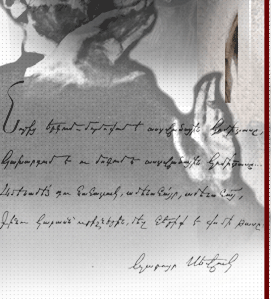| ARTICLES
OF KOMITAS ABOUT CHURCH MUSIC
ARMENIAN
ECCLESIASTICAL MELODIES
Tradition assigns the creation or codification
of ancient Armenian church melodies – which are most likely
an outgrowth of the era when the Armenian alphabet was invented
– to St. Sahak. Until the invention of the alphabet, the Armenian
church sang only psalms. In time, the practice of sharakan singing
developed alongside the singing of psalms.
What kind of melodies were used to sing the psalms is not clear;
most likely they were sung in ancient folk melodies.
The invention of the alphabet and the translation of the Bible in
the fifth century produced sacred songs. Gradually, the ritual and
liturgy of the church developed, as did a body of sacred songs.
There arose a number of singers who composed sharakans (hymns),
chars (homilies) and nerboghs (odes) designed to interpret the meaning
of ecclesiastical, dominical, and saints’ feasts to the people.
Ultimately, the singing of psalms was replaced by the singing of
sharakans.
Sharakan singing was supplemented by the singing of taghs (special
chants), gandzes (ascriptions), avetises (annunciation chants) and
other types of sacred songs to accommodate the requirements of the
increasingly elaborate liturgy. These taghs, meghedies, avetises
and the other sacred songs were all odes that were sung by the congregation.
The total number of the main sharakan modes and their subtypes is
forty. That of the other sacred songs is one hundred fifty-two.
This proliferation of tones is explained by the fact that the melody
types of taghs, gandzes and other sacred songs were constantly modified
and developed over the centuries according to the tastes of the
people using them, for the use of specific tones was not required.
By comparison, the tones of the sharakans were mandatory and their
use restricted; hence, they have not essentially changed. These
tones retained their integrity even through the nineteenth century,
when some tiratsous (cantors) began to corrupt the former simplicity
of the melodies, competing to outdo one another with the addition
of whimsical embellishments and gurgles to please their patrons,
the rich amiras of Constantinople, who nurtured a special love for
liturgical music. Nevertheless, the tones of the sharakans have
come down to us essentially unchanged.
By Manrousoumn (adjuvant studies), musicians of the past had in
mind the study of church songs, modes and neumes. Those who knew
the Manrousoumn well were perhaps a select few who kept their knowledge
a secret, very much like the Armenian notajis (notemongers) of Constantinople
fifty years ago, who made the true modern Armenian notation system
a matter of their bread and butter. Had the musicians of old, who
were called sages or philosophers in their time, not concealed their
knowledge, we would have obtained, along with the numerous manuscript
songbooks and anthologies, a number of manuals about the old neumes
and modes, which would explain the Manrousoumn.
ARMENIAN CHURCH MUSIC
Armenian Folk and Church music are based not
on the European tonal system but on the system of tetrachords, such
that the last note of one tetrachord serves as the first note of
another. The principal tetra-chord in Armenian music is the major
tetrachord, whose first and last notes remain fixed, while the middle
ones are changed.
MUSIC OF THE DIVINE LITURGY
Our folk and church melodies, which are like
brother and sister to one another and have the same formation, are
both composed on this principle of tetrachords. Melodies which do
not conform to the system of tetrachords are of foreign origin.
Our music, both in its style and its national spirit, is as much
Eastern as it is Persian-Arabic music; however, neither is the Persian-Arabic
music ours, nor ours a part of theirs. Ours may have been influenced
by theirs, but that is another story. In a like manner, our language
is a branch of the Indo-European family, as are the Persian, Kurdish,
German, and other tongues; yet Armenian is neither German, nor Kurdish,
nor Persian.
The rules of accentuation in music and in speech are closely related.
The accents of the music and the poetry must agree to create a work
of concord. Otherwise, a composition would be confusing, with speech
stressed where music is not and vice versa, and hence the melody
would be ill wrought.
THE SIGNIFICANCE OF THE
NEUMES OF THE SHARAKAN
It is true that I have discovered the key
to the Armenian neumes, and even can decipher the simple scripts,
but I have not yet completed my research. Often months elapse studying
even some ten manuscripts in order to fully penetrate the mysteries
of a single neume. Indeed, the neumes that I have hitherto identified
number 198, which have names, without mentioning the unnamed ones
which are countless.
May the Armenian public be forgiving, and especially patient, until
I bring to completion my laborious research that has extended over
more than sixteen years. I am hopeful that in the near future it
will become available to the public in separate volumes.
|


